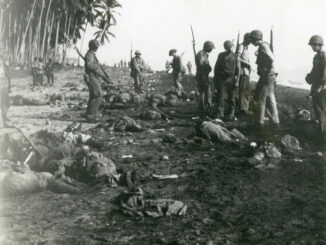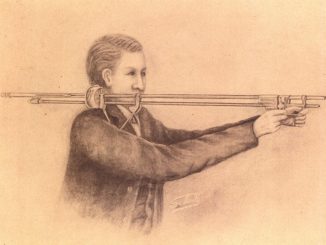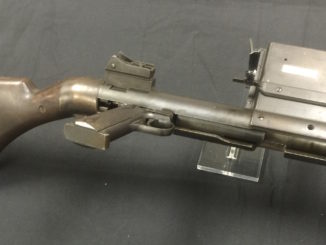The Reising Model 60 was the semiautomatic-only variant of the Reising Model 50 submachine gun. Offered side by side with the submachine guns, the Model 60 was also chambered for .45ACP and used the same magazines and a closed-bolt operating system that was identical except for the lack of a full auto option on the safety/selector switch.
The Model 60 was made between 1943 and 1949, and only about 3250 were made in total. They were used by a variety of factory guards, railway guards, and police units during WWII – people who needed a firearm, but not necessarily the amount of firepower available from a fully automatic one. H&R promoted the Model 60 (with its 18.25 inch barrel) as a particularly accurate gun suitable for making precise shots at longer ranges that could be done with an SMG.




“Model 60 (with its 18.25 inch barrel)”
I am wondering about how it affected muzzle velocity, in comparison to 11″ (M50 Reising sub-machine gun) muzzle velocity, so I check what Ballistic By The Inch says: http://ballisticsbytheinch.com/45auto2.html
Bufflao Bore Std P 230 gr. FMJ-RN seems to be closest to U.S. WWII iteration of .45 Auto cartridge – others have different bullet mass or type (for example JHP) or both.
Muzzle velocity for 18″ is given as 985, not velocity is given for 11″ so I assume it to be mean between 10″ and 12″ which would give 976. Gain is 9, very moderate for such barrel elongation. However it is possible that genuine load for .45 Auto behaved otherwise against barrel length alteration. Main problem with accuracy of .45 Auto weapons, is it rainbow-like trajectory – so any errors with distance assessment to target will have big influence.
Say, we fire .45 Auto at 985 fps and have sights set for 250 yards:
Here is trajectory: http://www.shooterscalculator.com/ballistic-trajectory-chart.php?t=83375768
If we make error and target is actually 275 yards away, it will land over 17 inches lower than point-of-aim, if 300 yards away – it will land over 38 inches (almost 1 meter).
Yes. 400 yards is extremely optimistic effective range for .45 ACP even from such a long barrel. I don’t think any standard pressure load would behave much differently, either. If you look at the BBTI numbers for .45 ACP overall, it seems that all loads they tested gain hardly any extra velocity from barrels longer than about 12″.
Really? A submachine gun used for long distance shooting. I would suggest a different, more appropriate weapon. 🙂
Remember that *at that time*, the limit for a Title I “rifle” versus a Title II “Short Barrelled Rifle” was an 18″ minimum barrel length (shotguns retain this limit today – it was only changed for rifles because the M1 Carbine is supposed to be *exactly* 18″… which meant that when CMP was selling carbines, some people were inadvertently getting guns that were just barely NFA violations…).
Just as an “M4gery” has a barrel a skosh over 16″ to stay out of reach of the NFA, they gave these 16.25″ barrels to avoid NFA hassles. After all, if you’re going to pay basically the same price for the gun (remember, this was before May 1986) from the manufacturer, *and* have to pay the same NFA tazes and deal with the same NFA headaches, might as well get the original buzzgun, right?
Interesting – again I was not aware of this variant (looks like I need to read up on the Reising). I do find a pattern, along with the attempt AutoOrd made to sell a civilian version of their product.
Both failed miserably, presumably because nobody really wanted a castrated version of the real thing.
If we compare it to sub-machine gun, it is surely inferior firepower fire.
However creating such weapon might stemmed from wanting to mimic revolver – lever-action carbine (for common cartridge) in for of automatic pistol – self-loading carbine. This would be attractive option for users of .45 pistols, as it wouldn’t complicated supply of ammunition.
Reminds me of the Marlin Camp Carbine in 45 ACP that used 1911 magazines. Neat concept, but the rainbow trajectory of 45ACP held it back also. It was introduced in 1985 then dropped in 1999.
.45 Auto is ill-suited for that application, I think .38 Super would be better for automatic pistol – self-loading carbine.
.22 TCM seems to be also interesting option, as it was designed, with ability of reworking .38 Super weapons for it: http://www.rifleshootermag.com/reviews/review-the-22-tcm-cartridge/
These are fun to shoot plus they still have a rather loose connection to WW II useage something other 45 cal carbines lack like the Hi Point and Marlin camp carbine.
Indeed. Pistol caliber carbines are rather popular right now, mostly based on some form of AR platform.
I’d buy one of these, just for kicks.
That’s just it. An AR-based pistol-caliber sub-carbine sells well. Anything less “tactical” looking does not. Witness the Marlin camp carbine in 9mm or .45acp, the Ruger PC9 or PC40 and so on…
Perhaps there’s a market for some sort of retro-styling. If there were, and the patents have expired or whatever, someone could probably manufacture a prototype Smith and Wesson that seems to have been envisioned for similar end-users as the Reising but in the über-popular 9x19mm Luger caliber:
Frank Iannamico, “The Smith and Wesson 9mm carbines” SAR Vol.8, No. 10 (July 2005) online since 10 May 2013:
https://www.smallarmsreview.com/display.article.cfm?idarticles=1856
Heck, for my purposes, I’d get one of those in a heartbeat. Again, just for kicks, but a lot of fun, and with some practical functions like varmint-hunting, a “truck gun” and in some sort of dire self-defense scenario, adequate if not ideal.
Seems to me this was a concept much like the M1 carbine. A more effective weapon than a pistol for your average guy. Being able to hit a target out to 200 meters or so. Also no need for another caliber. Pretty much just need to look at the popularity of pistol caliber carbines currently to see the idea has a lot of appeal to many people.
If I’m not mistaken, there was also a .22LR version, the Model 65. The Marines loved the Model 65 because it was good for getting rid of rats (you do not want rats eating your food supplies!!). Several examples came with scopes and/or suppressors attached, and I wonder if the suppressed Model 65 would have been good for harassing Japanese patrols somewhere in the jungle at the time (assuming it was kept clean)…
I saw one of these for sale 2yrs ago on a table at a local gun show for $600…..I blinked and it was gone 🙁
I read an old description of the Reising, by a fan of the design, which hinted that the gun wasn’t really intended for high-volume full auto fire. The 12 round magazine seemed (in their view) to be reasonable for semi-auto use, just as the 15 round M1 mag was.
At M1/subgun ranges, would a semi-auto have been better for vehicle crews, artillerymen etc.? And would .45 ACP have been a better choice than the .30 carbine.
The major purchasers of the Model 60 were bank armored car companies and state prison systems. Both guard force applications required a reasonable level of firepower and effective killing power, while also requiring limits on penetrative power for safety and legal liability reasons. A .45 ACP bullet traveling at velocities slightly greater than a pistol-length barrel could generate seemed to be a sensible answer.
It must be noted that prior to WW2, the most common “guard guns” in these applications were Winchester lever-action carbines, often in .44-40 WCF as opposed to the more powerful (and more penetrative) .30-30 WCF. A .45 ACP out of a 16-inch barrel approaches the ballistics of the .44-40 out of a 20-inch barrel, and in the Model 60 had the advantages of self-loading action and greater magazine capacity. Plus faster reloading in the unlikely event that it would be required.
Model 60s used to be quite common here in Ohio, as the State Department of Corrections bought them for use by tower guards at our state prisons. They came on the surplus market in the 1980s, when they were replaced by Ruger Mini-14 .223 carbines.
BTW, the SOP for the use of either one was called “fire once to warn, once to wound, and once to kill”. Unless of course the would-be rioter, escapee, or etc. was shooting at you with something. At which point Shots One and Two were bypassed and you went directly to Shot Three.
cheers
eon
The last case would also present the question “Why did you shoot the man 20 times?” The answer would be that 20 cartridges were loaded per magazine and that nobody had crafted a 30 (or more) round magazine for the guard’s usage.
Odd fact; the Ohio State Bureau of Prisons (as it was known then) was one of the few customers for the Model 1893 Police Gatling Gun made by Colt;
http://images.gunsinternational.com/listings_sub/acc_401/gi_100627135/FURR-1893-POLICE-MODEL-SCALED-GATLING-GUN-22LR_100627135_401_2B931574F583AC0D.jpg
This is photo of an operating 1/2 scale model in .22LR. The originals were made in .44-40 WCF, and AFAIK were never made in any other chambering.
Approximately two dozen were bought as tower guns for Ohio prisons in 1894-95. At the same time, the Cincinnati Police Department bought at least three, except theirs were on wheeled mounts similar to the larger rifle-caliber Army Gatling guns;
http://police-museum.org/greater-cincinnati-police-history/cincinnati-police-gatling-gun/
Considering their caliber, the 1893 Police Gatlings could almost be seen as forerunners of the submachine gun. Especially considering that their replacements with law enforcement in Ohio tended to be SMGs, or at least “SMG-like” weapons like the Reising Model 60.
cheers
eon
Quick question…upon firing the Model 60 (as well as the full auto version) does the charging handle reciprocate within its recess? Or is it inert?
Does anyone have knowledge of a 9mm Reising rifle? I have some photos of it but do not have any info. It is numbered U.S. No 1